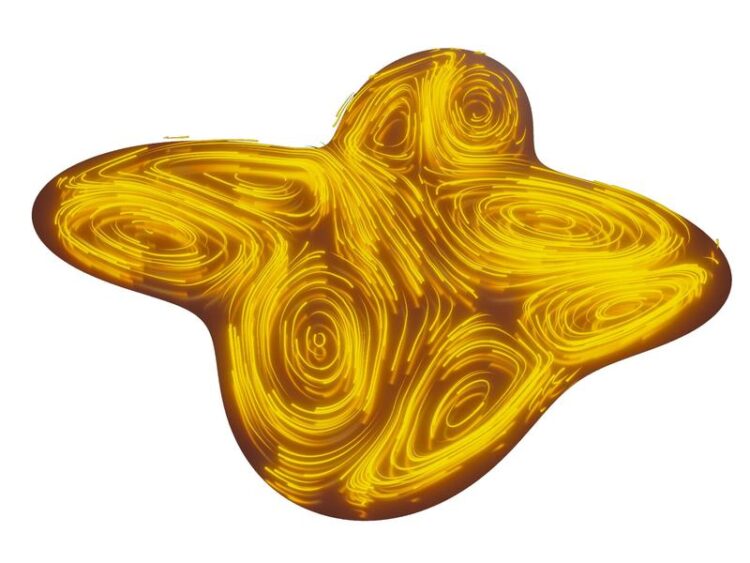Guiding microbes along their path

Illustration of the movement flux of the microbe in a defined 2-dimensional environment. The researchers observed that the movement path of the microbe directly depends on the curvature of the compartment.
(c) Esinam S. A. Dake, Jan Cammann, Marco G. Mazza
The direction of movement of a microbe directly depends on the curvature of its environment – this is the key finding of a recent publication in the journal PNAS with participation of the Max Planck Institute for Dynamics and Self-Organization (MPIDS) in Göttingen. The researchers investigated the navigation of a model microbe, a small self-propelling microalga, in confined compartments with different shapes. They also developed theoretical models to predict the probability flux of that microswimmer which was confirmed by experiments. With this model available, it is now possible to pre-define the average trajectory of such microbes by manipulating their environment.
The interdisciplinary field of active matter physics investigates the principles behind the behavior and self-organization of living organisms. The goal is to reveal general principles that allow to describe and predict the performance of living matter and thereby support the development of novel technologies. Recently, the groups of Oliver Bäumchen and Marco Mazza from the MPIDS, the University of Bayreuth and the University of Loughborough in the UK published their results on the model describing microbial navigation. “As microbes are often challenged with navigating through confined spaces, we were asking ourselves if there is a pattern behind the microbial navigation in a defined compartment”, they explain the approach. To answer this question, the researchers followed a single motile microbe and experimentally determined the probability flux of its movements. That is to say, they subdivided an predefined compartment into sectors and determined the probability of movement direction for each sector. In this way, a map was created according to which the navigation behavior of the microbe can be predicted.
The curvature determines the flux
Surprisingly, the microbe was found not to move randomly though the open space. Instead, the average movement pattern was both highly organized and symmetrical: the map of movement patterns showed a defined distribution of probability fluxes. “In particular, the strength of the flux was found to depend on the curvature of the adjacent solid interface: a higher degree of curvature resulted in a stronger flux” explain Jan Cammann and Fabian Schwarzendahl, the lead authors of the study. For practical reasons, all measurements were done in a quasi 2-dimensional environment, meaning that the microbe was confined from the top and bottom to better monitor its movement and avoid defocusing. Observing its movement pattern, the group of Marco Mazza (University of Loughborough and MPIDS) created a model to predicts the probabilities to flow in a certain direction. This model was then applied to compartments with more complex interface curvatures and experimentally verified by the lab of Oliver Bäumchen (MPIDS and University of Bayreuth). “It turns out that the curvature of the interface is the dominating factor which directly determines the flux of the self-propelling microbe.”, Bäumchen summarizes.
A technological implication for the future
As this discovery constitutes a fundamental observation, the model might as well be applied to other areas of active matter physics. “With our model, we can basically statistically predict where the object of interest will be in the next moment”, Mazza reports. “This could not only significantly improve our understanding of the organization of life, but also help to engineer technical devices.”
Understanding the principles behind the organization of active matter therefore can have direct implications on our future technologies. Potential applications of the model could be directing the movement of photosynthetic microorganisms in such a way so their flux can propel a generator, which would be a direct way to convert sunlight into mechanical energy. But also, in the pharmaceutical and healthcare sector, the findings of the scientists might be applied: “A potential application in the medical sector is the development of micro-robots delivering drugs to their specific destination in an efficient manner”, Bäumchen concludes.
Originalpublikation:
Media Contact
All latest news from the category: Life Sciences and Chemistry
Articles and reports from the Life Sciences and chemistry area deal with applied and basic research into modern biology, chemistry and human medicine.
Valuable information can be found on a range of life sciences fields including bacteriology, biochemistry, bionics, bioinformatics, biophysics, biotechnology, genetics, geobotany, human biology, marine biology, microbiology, molecular biology, cellular biology, zoology, bioinorganic chemistry, microchemistry and environmental chemistry.
Newest articles

Innovative 3D printed scaffolds offer new hope for bone healing
Researchers at the Institute for Bioengineering of Catalonia have developed novel 3D printed PLA-CaP scaffolds that promote blood vessel formation, ensuring better healing and regeneration of bone tissue. Bone is…

The surprising role of gut infection in Alzheimer’s disease
ASU- and Banner Alzheimer’s Institute-led study implicates link between a common virus and the disease, which travels from the gut to the brain and may be a target for antiviral…

Molecular gardening: New enzymes discovered for protein modification pruning
How deubiquitinases USP53 and USP54 cleave long polyubiquitin chains and how the former is linked to liver disease in children. Deubiquitinases (DUBs) are enzymes used by cells to trim protein…



